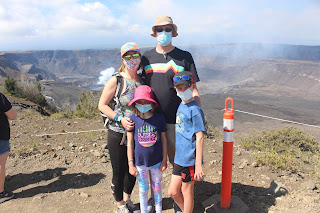 |
| Family pic at the Kilauea volcano |
 |
| Family pic (no masks) in warm Hawaii! |
Aloha! The Big Island of Hawaii is not the first place most people think of when they think about the white sand beaches and big surf of Hawaii. Yet it is actually the most modern and youngest (geologically speaking, that is) of all the islands.
Size
It is the largest of the Hawaiian islands, hence the name (yet only a mere 93 miles north to south and 76 miles east to west). It also boasts the tallest mountain on earth! No, not Mt. Everest. That's in Nepal. According to my 9 year old son, Mauna Kea on the Big Island is actually the tallest (sea) mountain and is 4,000 feet taller than Mt. Everest at 33,500 feet. It currently sits over the Hawaiian hot spot, a plume of magma, under the surface of the Pacific tectonic plate. The magma makes Kilauea an active volcano and the mountain goddess, Pele (PAY-LAY), controls her flows. Unpredictable? Very. Terrifying? At times. Out of this world? Definitely!
History
Hawaii became the 50th state of the USA in 1959. Starting as a U.S. territory just before 1900, Hawaii has a long history. Native Hawaiians and Pacific Islanders can trace their ancestry to Polynesia. King Kamehameha I created the Kingdom of Hawaii in 1810, shortly after Captain Cook first "discovered" the sandwich islands. Trade and modernization had its benefits but also at a cost. A key military base lead to the bombing of Pearl Harbor on 12/7/1941. A U.S. trade partner since the early 1800s: sugar and sandalwood then pineapple plantations and other things were extracted with little regard to the impact on the environment or Hawaiians. Early plantation owners, whaling ships, and missionaries also brought diseases and customs that changed the Hawaiian culture.
 |
| The yellow hibiscus is the Hawaii state flower |
Did you know it is wrong to call all people of Hawaii "Hawaiians" as we often say those who live in Minnesota are "Minnesotan"? Hawaii residents, those who live (and may have been born on the island), also are not all Hawaiian ethnically. Those who live on Hawaii today often refer to the mainland as "America" and Hawaii "Hawaii." While many Hawaii residents and Hawaiians are American by nationality, Hawaiians fight to protect and preserve their Hawaiian culture. It is an amazing place that we are fortunate to visit without a passport!
Kohala
We started our two-week journey in Kohala where I attended a medical conference on echocardiography daily from 7-noon. Vaccines, check. Boosters, check. Masks, check. It was the first in person conference I have attended AND the first time the kids had been on a plane in two years.
 |
| Ready or not, here we go! |
It wasn't as scary as I had anticipated traveling. We welcomed the 100 degree temperature change (-20 to +80 degree F) and the conference was very well done. Back home, schools were moving to remote learning as Omicron cases soared nationally.
 |
| Social distancing at the conference |
Grandma and Grandpa Pastorius met us there. The kids enjoyed opening their presents - new swim suits, dive toys, travel games, Nintendo game, necklace, sun hats and sandals. Given the four hour time difference, we often woke up early. I enjoyed running, doing yoga or just taking a sunrise walk along the rocky shore. Most beaches are inaccessible by car as the shoreline is made of up of eroding steep, black cliffs formed by A'a (AH-AH) sharp lava rock.
 |
| Sunrise run along the beach |
 |
| Walking along the lava beach trail at sunrise |
 |
| The view from the lobby of the pool and ocean at the Fairmont Orchid |
 |
| We stayed at the Fairmont Orchid and orchids scattered the open air hallways |
Reef
Beneath the waves on the leeward (kona) side along the lava seabed are incredibly diverse coral reefs. First, we snorkeled in the protected bay by the Fairmont Orchid hotel in Kohala. We spotted two green sea turtles, or honu (HOE-NOO). The kids enjoyed taking pictures with the GoPro. However, they got scared by the venomous red sea urchins on the rocks by the shore and decided to snorkel and play catch in the heated pool instead. Most days were spent relaxing by the pool while I attended the conference and then playing at the beach and back to the pool and a quick dip in the hot tub before cleaning up for dinner.
One day I went solo on a boat trip with a local dive shop, Jack's Diving Locker. On my first dive, we spotted four beautiful manta rays at a cleaning station, including one named Quarantina, a baby ray first seen in March 2020, hence her name.
 |
| Me scuba diving by the manta rays |
On the way to my second dive, spinner dolphins surrounded the boat and jumped in the waves. A humpback whale blow rose up over the horizon.
 |
| Dolphins |
 |
| Spinner |
The second dive site had schools of fish along a protected reef by the old Kona airport. The reef disappeared into the deep blue and seemed to go on forever. I peeked my head in a cave to see a white tip reef shark resting. As I turned around, a small octopus swam past and then immediately disappeared. It was perfectly camouflaged into the reef such that it was impossible to spot. Two moray eels poked their large white mouths out of the coral signaling for us to leave.
 |
| Large moray eel |
Dinner
Our first night on the island we enjoyed robatayaki (grilled skewers) at Binchotan and lilikoi mai tais. After dinner we headed up to Hapuna Beach Resort to stargaze with fancy astrographic imaging telescopes. Wayne taught us to see up close the craters on the moon, Jupiter and 3 of its moons, distant galaxies and a nebula (cloud of dust ready to become a nursery for new stars). It was a great start to vacation.
 |
| Stargazing |
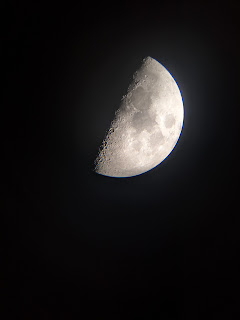 |
| Craters on the moon |
The next day we spent by the pool and in the evening we drove up to Waimea to Merriman's for an exceptional farm-to-table meal. I had the signature Merriman's mai tai cocktail (Old Lahaina Light and Dark Rum, Lime, Macadamia Nut, Orgeat, Curaçao, Honey-Lilikoi Foam), grilled octopus and white shrimp, and coconut creme brule for dessert. To die for!
 |
| Merriman's mai tai with honey-lilikoi foam |
 |
| Port and creme brulee |
The following night, we walked along Waikoloa beach and got a table at the Lava Lava Beach Club just as the sun was setting over Anaeho'omalu Bay. It was unforgettable: toes in the sand, seared ahi tuna in our bellies, and the ukulele played "Somewhere Over the Rainbow" as a professional hula dancer swayed in the gentle breeze.
 |
| Waikoloa beach |
 |
| Yum yum pineapple and chicken fried rice |
 |
| Lava Lava Beach Club at sunset |
Road Trip
After the conference, we drove to the other side of the island. First stop was the Waipi'o Valley overlook (but decided not to try the 25% grade single lane road down to the beach).


We drove past some former sugar plantations, now eucalyptus tree farms, before stopping for some panoramic views and to learn about the deadly tsunami of 1946 at Laupahoehoe Beach Park. The waves were crashing along the black rocks sending spray 50 ft. in the air.


We continued along the windward side by Hilo. This is the wettest spot in the U.S.A. It has luscious green forests and beautiful waterfalls courtesy of the heavy rainfalls. It rains 20 days per month but often only briefly at night. We stopped to hike to the 420 ft. Akaka Falls. Unfortunately, the sun was setting so we didn't see a rainbow at Rainbow Falls.
 |
| Akaka falls |
 |
| Rainbow falls |
 |
| Invasive mongoose near Hilo |
Just before dark we headed down into the Kaumana Caves where we experienced total darkness. These underground in lava tubes around the town of Hilo go on for over two miles. Armed with only a camera and headlamp, we became amateur spelunkers and only made it about 300 ft. in each direction before turning around.
"Wet, moist and scary," said Theo after exploring the cave. Drip-drip-drip, the dark cave echoed. Hanging roots and stalactites hung from above. (Anyone else learn about spelunking from playing too much "Where in the World is Carmen Sandiego?" on a "hard" disk back in the day?) For dinner, we found an art fair with local food trucks and live entertainment in downtown Hilo. It was fun to get a feel of the real (not tourist) side of the island.
It was dark when we arrived at the Aloha Junction Bed and Breakfast just outside Hawaii Volcanoes National Park. It definitely wasn't the Fairmont (and Theo had to sleep on the floor) but the location was perfect and Robert the host was fantastic.
 |
| At the kaumana cave entrance |
 |
| Climbing into the lava tube |
 |
| Inside the lava tube in a room with tall ceilings |
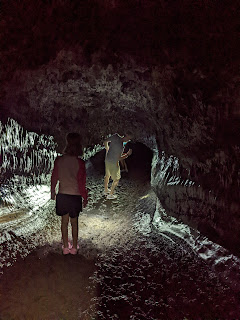 |
| Spelunking and ducking under narrow parts with A'a lava streaks on the walls |
Hawaii Volcano National Park
The morning we had breakfast of papaya with sliced bananas and a little lime. So delicious!
 |
| Delicious papaya and bananas |
 |
| Entering Hawai'i Volcanoes National Park, established in 1916 |
We entered the park before the rush. Did you know there are different words for lava? Pahoehoe (PA-HOY-HOY) and A'a (AH-AH) lava. Pahoehoe is very smooth, unbroken and sometimes wavy and wrinkled in appearance. Caused from extremely hot lava after it streams down and hardens. A'a is stony, rough, jagged and is formed as piles of slow moving clinkers harden.
 |
| Pahoehoe smooth lava |
 |
| Jumping off lava |
We walked through some steam vents and drove around the crater. We saw the old sunken road on the hike to the crater. For lunch we drove down to the coast where the 2018 lava flow covered the road. A short hike across the pahoehoe and we found the petroglyphs, ancient images and holes etched into the lava. On our way back up the volcano, we stopped to see some old tree molds, formed when hot lava flowed and very wet trees were covered in up to 10 feet of lava but didn't burn. The lava formed around them and eventually the trees died and left a hole. We also walked around a lush oasis of old Hawaiian forest on the 1.2 mile kipukapuaulu trail (bird park).
 |
| Smoking hot steam vents |
 |
| The trail to the rim by more steam vents |
 |
| Petroglyphs |
 |
| Tree mold with 10 ft. of lava surrounding a hole |
 |
Hiking in bird park
|
 |
| At the coast where the lava flows into the sea. Can you spot the lava arch? (behind Seth on the shore) |
Over 90% of all native species on Hawaii are endemic, including the state bird: the Hawaiian goose, or nene (NAY-NAY). Apparently lost in a hurricane, this is a distant relative of the Canadian goose. It can't actually fly and has adopted to walking on A'a lava (as well as beautifully groomed golf courses) without any major predators (besides the pesky invasive mongoose).
 |
| Family of nene on the hike to the crater |
The mongoose, a small weasel-like critter, was introduced in the 1880s by the sugar plantations to control the rat populations. Unfortunately, these animals had devastating affects on native bird and sea turtle nests. Mostly because the mongoose are active during the day and had minimal impact on the nocturnal rats. Active efforts to keep them out of the national park and rebuild the nene populations are ongoing.
 |
Hiking down to the Halemaumau Crater
|
 |
| Marit and Mommy at the Kilauea Volcano crater |
 |
| Grandpa, Seth and Theo at the crater |
 |
| Sink holes on Devastation Trail |
After dinner in Volcano, we drove back into the park and took our headlamps out to walk back a mile to see the glowing lava in the crater at night.

Marit asked Grandpa, "What's the big deal with the lava?"
We told her this was one of only 30 active volcanoes in the world. Despite being an active volcano since 1983, this was the first time I had ever seen lava in my life and it was spectacular! I can't imaging seeing it flowing in 2018.

Visiting the Big Island reminded me that our lifespan is a nanosecond in geologic time. There are galaxies and things in space beyond our imagination. There are new stars forming and old stars that are dying. New islands are rising up from the seabed as others slowly erode. So much change can happen in geologic time.
Back to Kona
Lava does make for spectacular black sand beaches, which are scattered around to 266 miles of shoreline. We stopped at a spectacular Punalu'u Black Sand Beach . The kids played in the tide pools while we watched the honus waddle up the shore.
 |
| Punalu'u black sand beach |
 |
| Tide pools |
 |
| Honu |
Before arriving at our condo rental in Kona, we stopped to snorkel at "Two Step." There were two flat lava rocks that were perfect for stepping into (and out of) the water. As soon as we put our masks underwater we saw schools of yellow tang fish and my personal favorite fish, the lauwiliwilinukunuku'oi'oi, yellow longnose butterflyfish. Not to be confused with the state fish, the humuhumunukunukuapua'a, or reef or rectangular triggerfish. (Theo was quizzed on this during our snorkeling trip and it's pronounced: WHO-MOO-WHO-MOO-NOO-KOO-NOO-KOO-A-POO-A-A. Easy for your to say, right?)
Around the corner from "Two Step" was the Royal Palace and place of refuge - Puuhonau o Honaunau national historic park. Theo and Marit learned about Hawaiian history and earned their second Junior Ranger badges of the trip.
 |
| The place of refuge, Puuhonau o Honaunau |


The next day, surf was up and the beach was closed due to the tsunami wave (more about that below). We decided to go snorkeling anyway at Kahalu'u Beach Park but had to enter on the surfing side where the waves were bigger. It was a tough swim to get into the cove but we saw some new things - a green leaf scorpion fish, a starfish and a sea slug.
That night we embarked on a boat ride we will never forget: manta ray night snorkeling.
I think whether you do this as a night dive or as a snorkeling trip, you will be blown away. These large gentle giants have lived in these cold ocean waters for decades. Approximately 320 of these creatures call this area their home. Every night they come up for dinner to feed on tiny plankton that are attracted to the lights of the hotels and dive boats. During the day, they visit "cleaning stations" where cleaner fish atop a coral reef eat the parasites from their skin. They gracefully swim up, often from deep ocean below and glide slowly by. Then, they somersault or twist around one another almost touching and synchronously slide by nearly touching our masks and wetsuits. They can feel our heart racing.
 |
| Jumping on the boat to manta ray snorkel |
 |
| Going out to sea to get to manta ray heaven |
Koie Ray, the easily identifiable manta ray swam by us the most that night. She was easily identified as her left cephalic fin was missing. Her fin was caught in some fishing line and a scuba diver amputated it and it healed ok. At 14 feet across, her impressive wingspan and large mouth terrified the kids.
Theo, scared of the deep water, started hyperventilating almost immediately when Seth dropped him in. He cried most of the time and said he was "too cold, too cold." Marit, age 7, was also terrified and scared (and cold) but was too nervous to say anything. She floated between Grandma and Grandpa so Seth and I were blissfully unaware she was not enjoying herself. Theo and Marit quickly swam back to the boat with the instructor when given the opportunity after 15 minutes. We had a good laugh, foolishly thinking the kids would enjoy swimming with giant creatures when they could easily fit inside their mouths. In the end, the kids said it was the highlight of their trip. I know I enjoyed floating among these giants rays and watching the plankton and fish under the light of the surf board at sunset. Manta ray pictures and video will be posted later.
Tsunami
While we were on the Big Island (but not in the water), a massive volcano erupted in Tonga and obliterated the island. It sent a 15 meter tsunami wave that hit nearby islands and sent an ash cloud 12 miles in the air that covered the region. The tidal wave made it all the way to the Big Island. While not large enough to trigger the alarms for evacuation via the tsunami warning system, the wave did cause some damage to coastal sea walls in Kona. The local park by our condo was closed and a fancy pool at a local resort was flooded. It also damaged the Seaquest dive shop next to the marina in south Kona. No one was injured in Hawaii but death toll in Tonga is likely to be high, unlike devastating tsunamis in Japan and SE Asia in recent history, but it makes you respect the ocean and unpredictable and ever changing conditions that we are living in.
Sunset
One of our last nights on the Big Island, we enjoyed fried calamari and panoramic views at sunset at Sam Choy's. "What a view," I said.
 |
| View from Sam Choy's restaurant |
"What view?" Marit asked focused on her magnetic checker game with Theo as the sun set reflecting on the ocean and the sky turned bright pink and orange. Sigh. Maybe one day they will appreciate it.
Boat tour
Our last day on the Big Island, we took a 5-hour boat tour to snorkel. First stop was Honaunau (HOE-NOW-NOW) bay with schools of raccoon butterfly fish, needlefish and yellow tang scattered along the reef. Large trumpetfish and giant parrotfish glided past. Next, we swam at a reef along the southern coast under a lava caves formed from crashing waves eroding the lava. Last, we headed north to Kaelakekua bay by Captain James Cook's obelisk. The water was crystal clear and they say the reef in "Finding Nemo" is based on this spot. Three bottle-nosed dolphins jumped up in the bay and a humpback whale blew out her spout twice before diving down and showing off her fluke (tail). It was picture perfect (if only I had my camera ready). Fish pictures and snorkel video will be posted later.
O'ahu
We said goodbye to Grandma and Grandpa at the airport and flew on a small plane from the Big Island to O'ahu. Uncle Drew picked us and we got lei'd (a sign of appreciation and friendship) in Honolulu. He took us to our beachside rental.
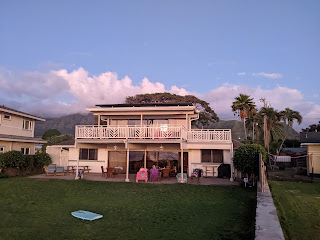 |
| Uncle Drew and Aunt Angie and Hope live on the leeward side near Makaha beach, 3 houses away from our rental. |
 |
| Hope, Uncle Drew, Marit, Seth and Theo |
The surf was up as a big swell was blowing in and conditions were great for surfing (but not so great for little ones to go boogie boarding). We walked along the beach and played in the foam as huge waves crashed along the shore.
 |
| Our front yard of the rental on Makaha beach |
 |
| We got lei'd! |
The next day we loaded up the yellow truck and went paddle boarding in a protected cove where we saw two honus. The kids floated on the boogie boards but there weren't any waves in the cove.
The last day in Hawaii we let the kids go boogie boarding. We played the waves the day before and figured it was a flatter, calmer part of Makaha beach. After watching a few sets come in, we decided to give it a try. Marit and I had fun riding in the "rollers" until a big set of waves came and crashed on us. Marit and I quickly swam out a little farther and rode it out just past the break. When that set died down, I quickly tried to swim back to the beach before another big set came in. Ahead of me I could see Theo was struggling as he lost his boogie board in a wave and was treading water. I called to Seth to help get him in as these waves were more than he could handle. Marit and I kept swimming in. Suddenly, our boogie board caught the top of a big wave and suddenly we were nose diving down. The wave flipped me over and tossed me in the wave. I lost hold of the board. And Marit.
I popped up and looked around but didn't see her. I was about to panic. I scanned the waves for a drowning child. Suddenly, her head popped up covered in white foam. She took a big breath but wasn't able to fully stand up. I rushed over to grab hold of her arm just as another wave broke on top of us. I held onto her bicep and rooted my feet in the sand as the strong undertow pulled us back toward the waves. She was like a rag doll and I dragged her by the arm up the shore and away from the waves. She was crying, covered in sand. She got her footing and ran up the rest of the beach. She grabbed her board and sat down on it at the top of the ridge. Fortunately, she wasn't hurt but she was stunned.
I turned back and saw Seth and Theo still in the water. They were duck diving under the tall waves. I yelled to Seth to get him out. Seth replied, "I can't! Come get him now." I ran back into the crashing waves and reached out my hand to Theo. He grabbed my hand and then we lost our grip as he was pulled back into the waves by the undertow. I went in farther and grabbed him by the wrist tight. I held on as the strong undertow pulled him back. Then, with the next wave broke we ran up and I pulled him up to the top of the beach out of the powerful undertow. Seth followed.
Theo sat down, exhausted, and said, "I hate the ocean."
We all caught our breath and eventually walked back to the house. It was time to say goodbye, pack up and head back to the mainland. We had a bonfire on the beach under the clear skies and milky way. We are fortunate to be vaccinated and able to travel, explore, learn and visit these natural places.
 |
| Family pic in lei's |
 |
| Uncle Drew and Seth |
 |
| Bonfire on the beach under the stars |
 |
| Makaha beach |
 |
| Watching for the green flash at sunset |
The Hawaiian islands are a way of life and home to an amazing and diverse group of people who celebrate their differences in a warm, caring and compassionate way. I am so happy I was able to relax and experience this beautiful place. There is a photo in my office that was given to me in medical school that reads:
"The only real voyage of discovery consists not in seeking new landscapes but in having new eyes." Just like Marco Polo or Captain James Cook, we are all born with an inner explorer. We seek to grow and evolve. Sometimes, rather than discovering new landscapes or going in a rocket to the moon, our journey involves exploring the cracks and crevice's inside of us and the journey allows us to reflect and evolve our belief systems. In doing so we change not only our perception of ourselves but the world around us. We all can use a change of perspective every once in a while and continue to grow and evolve. I hope your next adventure helps change your perspective as well.
 |
| Mahalo |
Thanks for reading.
More pics:
 |
| Canoe club practice |
 |
| Lava tubes |
 |
| Two step reef |
 |
| Captain Cook Monument |
 |
| Checking out the caves |
 |
| Sulfur fumes oxidize iron and paints the lava red |
 |
| Entering the Thurston Lava Tube |
 |
| Inside the Thurston Lava Tube |
 |
| Crater with yellow sulphur plumes |
 |
| Recent lava flows from the 1900s |
 |
She got a camera and it didn't take long to learn how to take selfies
|
 |
| The old road fallen into the crater |
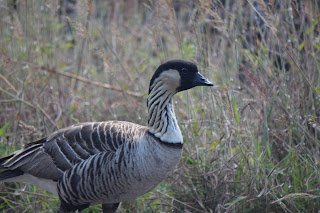 |
| Adult nene |
 |
| Baby nene |
 |
| honu |
 |
| honu |
 |
| lizard |
 |
| Male kaliji pheasants (non-native game bird) |
 |
| native butterfly on lava |
 |
| Saffron finch |



































































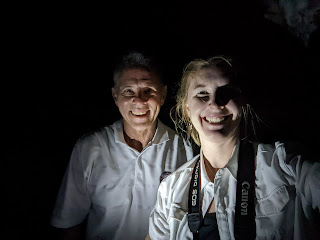









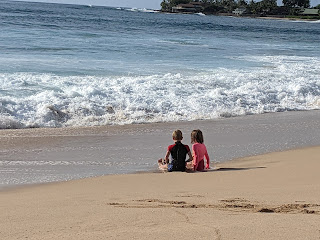









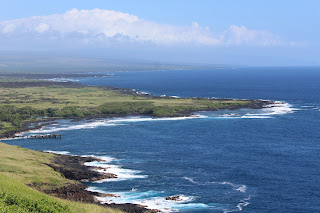












































I always love reading your blogs so I can remember what I have done on the VACA! Your attention to detail is remarkable and I appreciate your blog. What a wonderful vacation and thank you for inviting us to help join in on the fun! Love, momma
ReplyDelete